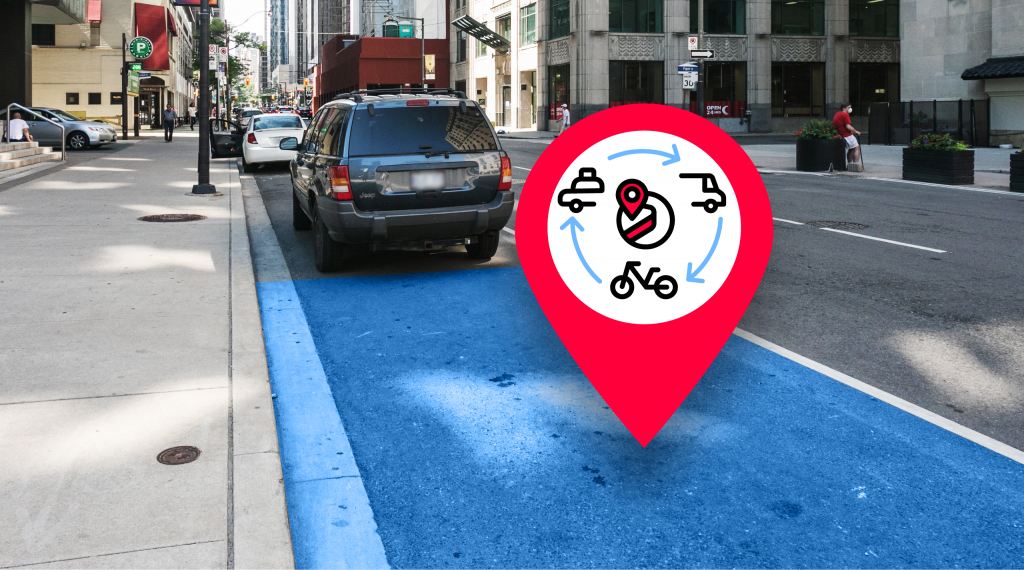
Curbside management is an emerging practice and terminology used for what was often considered by cities as “parking management.” The update in terminology reflects the changing priorities to shift the focus from private vehicles to other modes of transport. It infers a more holistic approach by looking at a wide array of curbside uses, as well as considering the curbside as a citywide network that can be activated. For example, creating bus or cycle corridors by repurposing the curb lane. The traditional management of the curbside is location-specific, and curbside regulations often correlate with its immediate adjacent building use. For instance, paid parking in front of shops, or free parking in a quiet residential area.
The demand for curbside use is increasing with the adoption of innovative solutions, including bike-share and e-scooters, car-share services, ride-hailing services, the growth of online shopping and associated freight deliveries, accessibility, and vehicle storage. Curbside management ensures that space is allocated to these uses in a way that benefits the sustainability goals of cities. However, with such an array of different users and uses, a larger margin of flexibility is needed for day-to-day operations to adapt to changing demands.
The traditional curb management approach is oriented around private vehicle parking and usage. It is static and changing the curb use requires going through a tedious built-in bureaucratic process. In contrast, the flexible curb is dynamic and can serve multiple uses. It is time based, agile, and can change its use according to demand.
Video by EIT Urban Mobility Academy. Check out the free short course on Flexible Curbside Management that was created by Future Mobility Network and CurbIQ.
Flexible curb management refers to ways that cities can optimize curb space that is in high demand in desirable areas. The flexibility allows cities to allocate the most suitable curb use to a specific location at a specific time. It implies different curb uses for different times, whether that is in the same day (for example peak and off-peak hours), or different periods of the year (for example, summer patios and winter snow clearing zones).
The curbside can be designed for seasonal flexibility, accommodating different activities in different seasons. For example, restaurant outdoor seating can be more prevalent in the warmer parts of the year. In this context, the curb lane can be repurposed for curbside patios (as implemented on a wider scale during the COVID-19 pandemic). Alternatively, the sidewalk can be used as an outdoor extension of restaurants, and consequently the curb lane can be repurposed as an extension of the sidewalk. This can be done through a raised platform to match the sidewalk level, or through built-in design features such as on Market Street in Toronto, where the street and sidewalk are leveled, and bollards can be reconfigured easily to summer mode (restaurant patio + sidewalk) or winter mode (no patios + parking lane).
New uses of the curbside have emerged that not only utilize the curb space in a different way, but also make better use of the curb over time. For example, a pick-up drop-off (PU-DO) zone can serve more people in a typical hour, with vehicles utilizing it typically for a minute or two over a space of 4-5 parking spots, compared with 5 parking spots that allow for very low utilization of the same space. Even the use of the PU-DO zone may be highly utilized in specific hours, depending on the location (in front of a theatre, sports arena, office complex, or hotel). During the times of day when there is low activity, the space can be utilized in other ways, such as for deliveries or loading.

Scheduling curb space can be facilitated through digital tools, such as CurbIQ’s Curb Manager. Scheduling implies ongoing regulations, temporal regulations during weekdays/weekends, daytime/nighttime, a one-off event, or a recurring activity.
When digitized, the flexible curb can be managed and controlled remotely and respond to real-time usage. This can attend to real time increase in demand, such as pick up or drop off activity at the end of large events. Or, it can quickly slot in loading zones during the times when there is less demand for parking. Another more direct way to implement flexible curb space is by the usage of digital curbside signage that can communicate the current regulation and change according to real-time demand.
The combination of flexible curb management with a digital curbside inventory and remote management tools allows for a greater optimization of curbside usage. The curb can serve more people with more mobility options at the times of day when there is more activity and demand. At the same time, it safe-guards time slots for cities’ important logistical activities such as the movement of goods, and allows more effective management and scheduling of places of permanence, such as patios and street closures.
A network of remotely managed and connected designated flexible curb space locations in the city can form the initial structure for a multi-modal mobility network. This network of curb space real estate allows for prioritization of shared-mobility, cycling infrastructure and transit throughout the city.
The importance of the flexible digitized curb space management is both in the spatial and temporal aspects of the curbside. As flexible and digitized curbside initiatives are adopted on a wider scale, a fundamental change in the way we use our streets can begin. We can imagine the future curbside as part of a responsive network of public spaces that are programmed to serve the cities’ demands and needs.
To learn more on flexible curb management access the free short course on Flexible Curbside Management, created by Future Mobility Network and CurbIQ.